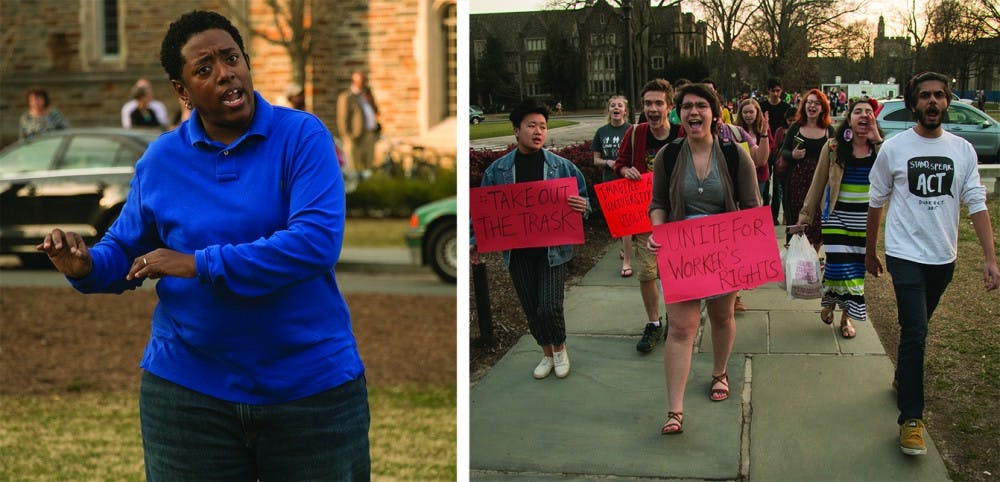Students and Duke community members gathered Tuesday to demand the resignation of Executive Vice President Tallman Trask and protest the mistreatment of employees within Duke’s Parking and Transportation Services department.
The protest came one week after The Chronicle reported in a two-part series that Trask hit a female contract employee with his car in 2014 and allegedly used a racial slur against her, and that current and former members described the department as hostile and discriminatory.
Approximately 25 students, who were joined by several former PTS employees, gathered at the James B. Duke statue in front of the Chapel then marched to the West Campus bus stop and Allen Building.
The former PTS employees—including Renee Adkins, who was the special events manager from 2003 until 2015; Reymond Milan, a former parking events specialist; and George Williams, a former event parking specialist—said they wished there had been a larger student turnout, but that they appreciated those who voiced their support.
“There is systemic racism on Duke’s campus, and that’s a fact,” Adkins said, speaking to the protestors. “Fear of retaliation is one of the reasons there aren’t more of us here today.”
Adkins, who was terminated Jan. 23, 2015 by PTS Director Carl DePinto, wrote an email Jan. 15, 2016 to President Richard Brodhead describing a culture of “racism, harassment, retaliation and bullying” in the department. She also wrote that after Trask hit a contract employee, Shelvia Underwood, there was neither a public administrative response nor a thorough investigation by Duke University Police Department. DUPD is overseen by Vice President for Administration Kyle Cavanaugh, who reports to Trask.
“No one is going to step up to the plate and do anything to Trask, Cavanaugh or DePinto,” Adkins said. “I don’t want anyone’s life to be ruined. I just want accountability.”
Milan spoke to the students gathered about the discrimination he had experienced within the department—noting that the first thing he asked for when he testified during arbitration on Adkins’ behalf following her termination was protection from retaliation.
“They told me there would be no retaliation, but the very next day, I came to work and had duties taken away,” Milan said.
The gathered students listened to the former PTS employees and spoke about their own visions for how the University could improve. Several noted that the turnout was lower than they had expected.
“It’s crazy that only 35 people are here,” one protester said. “I believe in reflecting on how much that is a piece of this puzzle. It’s such an apathetic campus.”
Several of the protestors, including undergraduate and graduate students, also described the incident with Trask and the culture within PTS as parts of larger issues relating to race and class on campus.
“The purpose of this campaign is to attack every facet and corner of institutional racism, starting with Trask,” one student at the gathering said.
Sue Wasiolek, dean of students and associate vice president for student affairs, joined several other faculty members who observed the gathering from a distance. The protestors also said that other men who were standing in sight of the gathering were DUPD detectives.
Wasiolek declined to comment on the gathering.
“We’re under surveillance, but the type of egregious crimes committed by Trask are not punished,” said Danielle Purifoy, a fourth year Ph.D. candidate and one of the protestors. “He is gallivanting around town, demonstrating that he believes he is above the law.”
A number of local media outlets—including WRAL and The Raleigh News and Observer—were on campus covering the story.
Felicia Arriaga, also a Ph.D. student who attended the gathering, said she had been in meetings about diversity all day and noted that she thought administrators were trying to come up with “a bandaid solution” for a much larger problem.
“They can put forward recommendations, but that won’t change anything—the problem is how to change the perception on campus that allows people to get away with this type of action,” Arriaga said. “What kind of university do I go to where it is okay to hit someone and have there be no consequence?”
Shortly after 5 p.m., as the gathering was occurring, an email was sent to students on behalf of the task force on bias and hate issues, noting that it recently launched a website with information about its work.
“Progress comes when all contribute and work together,” the email states. “We welcome you to the conversation and encourage your feedback as we work through these tough issues together.”
One student noted that a number of student groups—including the Asian American Alliance, Students for Justice in Palestine, United Students Against Sweatshops, Mi Gente, the National Association for the Advancement of Colored People, Blue Devils United, the Muslim Students Association, the Native American Students Association and Diya—signed the statement on Change.org calling for the removal of Trask. The petition had gained more than 250 supporters online as of Tuesday night.
“Where is everyone?” one protester asked. “There needs to be some kind of accountability. What would it look like for all those people to be here, to be willing to stand here. Imagine what kind of a difference that would make.”
The protestors gained attention as they moved from the statue to the bus stop to the Allen Building—chanting sayings including “Whose University, our University!” and “Hey ho, Trask has got to go!”
“We need to mobilize more,” one student protester said. “We pay tuition here—[Trask] is in charge of tuition, but we’re the ones paying it.”

